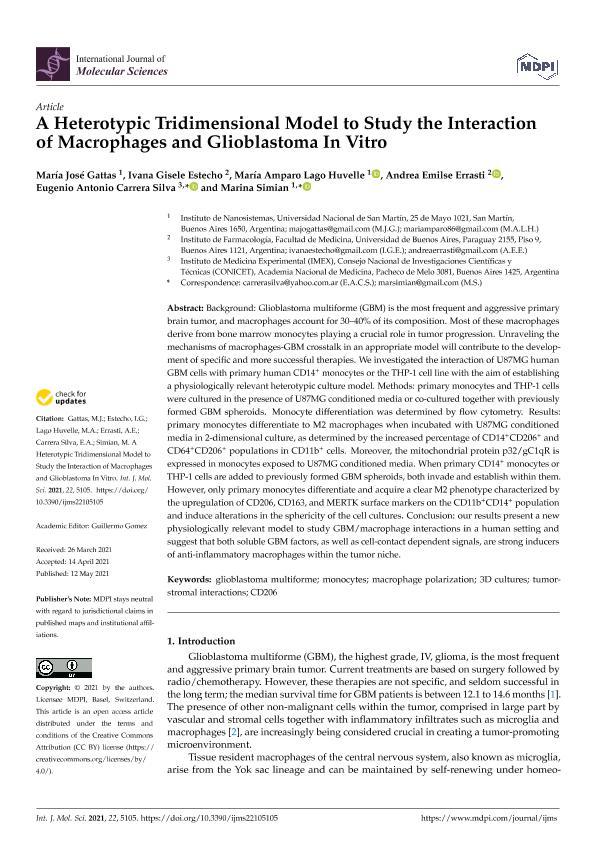Mostrar el registro sencillo del ítem
dc.contributor.author
Gattas, María José
dc.contributor.author
Estecho, Ivana Gisele
dc.contributor.author
Lago Huvelle, María Amparo

dc.contributor.author
Errasti, Andrea Emilse

dc.contributor.author
Carrera Silva, Eugenio Antonio

dc.contributor.author
Simian, Marina

dc.date.available
2021-12-07T12:28:14Z
dc.date.issued
2021-05
dc.identifier.citation
Gattas, María José; Estecho, Ivana Gisele; Lago Huvelle, María Amparo; Errasti, Andrea Emilse; Carrera Silva, Eugenio Antonio; et al.; A heterotypic tridimensional model to study the interaction of macrophages and glioblastoma in vitro; Molecular Diversity Preservation International; International Journal of Molecular Sciences; 22; 10; 5-2021; 1-15
dc.identifier.issn
1422-0067
dc.identifier.uri
http://hdl.handle.net/11336/148353
dc.description.abstract
Background: Glioblastoma multiforme (GBM) is the most frequent and aggressive primary brain tumor, and macrophages account for 30–40% of its composition. Most of these macrophages derive from bone marrow monocytes playing a crucial role in tumor progression. Unraveling the mechanisms of macrophages-GBM crosstalk in an appropriate model will contribute to the development of specific and more successful therapies. We investigated the interaction of U87MG human GBM cells with primary human CD14+ monocytes or the THP-1 cell line with the aim of establishing a physiologically relevant heterotypic culture model. Methods: primary monocytes and THP-1 cells were cultured in the presence of U87MG conditioned media or co-cultured together with previously formed GBM spheroids. Monocyte differentiation was determined by flow cytometry. Results: primary monocytes differentiate to M2 macrophages when incubated with U87MG conditioned media in 2-dimensional culture, as determined by the increased percentage of CD14+CD206+ and CD64+CD206+ populations in CD11b+ cells. Moreover, the mitochondrial protein p32/gC1qR is expressed in monocytes exposed to U87MG conditioned media. When primary CD14+ monocytes or THP-1 cells are added to previously formed GBM spheroids, both invade and establish within them. However, only primary monocytes differentiate and acquire a clear M2 phenotype characterized by the upregulation of CD206, CD163, and MERTK surface markers on the CD11b+CD14+ population and induce alterations in the sphericity of the cell cultures. Conclusion: our results present a new physiologically relevant model to study GBM/macrophage interactions in a human setting and suggest that both soluble GBM factors, as well as cell-contact dependent signals, are strong inducers of anti-inflammatory macrophages within the tumor niche.
dc.format
application/pdf
dc.language.iso
eng
dc.publisher
Molecular Diversity Preservation International

dc.rights
info:eu-repo/semantics/openAccess
dc.rights.uri
https://creativecommons.org/licenses/by-nc-sa/2.5/ar/
dc.subject
3D CULTURES
dc.subject
CD206
dc.subject
GLIOBLASTOMA MULTIFORME
dc.subject
MACROPHAGE POLARIZATION
dc.subject
MONOCYTES
dc.subject
TUMOR-STROMAL INTERACTIONS
dc.subject.classification
Inmunología

dc.subject.classification
Medicina Básica

dc.subject.classification
CIENCIAS MÉDICAS Y DE LA SALUD

dc.title
A heterotypic tridimensional model to study the interaction of macrophages and glioblastoma in vitro
dc.type
info:eu-repo/semantics/article
dc.type
info:ar-repo/semantics/artículo
dc.type
info:eu-repo/semantics/publishedVersion
dc.date.updated
2021-12-03T20:40:28Z
dc.journal.volume
22
dc.journal.number
10
dc.journal.pagination
1-15
dc.journal.pais
Suiza

dc.description.fil
Fil: Gattas, María José. Universidad Nacional de San Martin. Instituto de Nanosistemas; Argentina
dc.description.fil
Fil: Estecho, Ivana Gisele. Universidad de Buenos Aires. Facultad de Medicina. Instituto de Farmacología; Argentina
dc.description.fil
Fil: Lago Huvelle, María Amparo. Consejo Nacional de Investigaciones Científicas y Técnicas; Argentina. Universidad Nacional de San Martin. Instituto de Nanosistemas; Argentina
dc.description.fil
Fil: Errasti, Andrea Emilse. Universidad de Buenos Aires. Facultad de Medicina. Instituto de Farmacología; Argentina. Instituto Superior de Formacion Docente y Tecnica Numero 24 Doctor Bernardo Houssay.; Argentina
dc.description.fil
Fil: Carrera Silva, Eugenio Antonio. Consejo Nacional de Investigaciones Científicas y Técnicas. Instituto de Medicina Experimental. Academia Nacional de Medicina de Buenos Aires. Instituto de Medicina Experimental; Argentina
dc.description.fil
Fil: Simian, Marina. Universidad Nacional de San Martin. Instituto de Nanosistemas; Argentina. Consejo Nacional de Investigaciones Científicas y Técnicas; Argentina
dc.journal.title
International Journal of Molecular Sciences
dc.relation.alternativeid
info:eu-repo/semantics/altIdentifier/doi/http://dx.doi.org/10.3390/ijms22105105
dc.relation.alternativeid
info:eu-repo/semantics/altIdentifier/url/https://www.mdpi.com/1422-0067/22/10/5105
Archivos asociados
